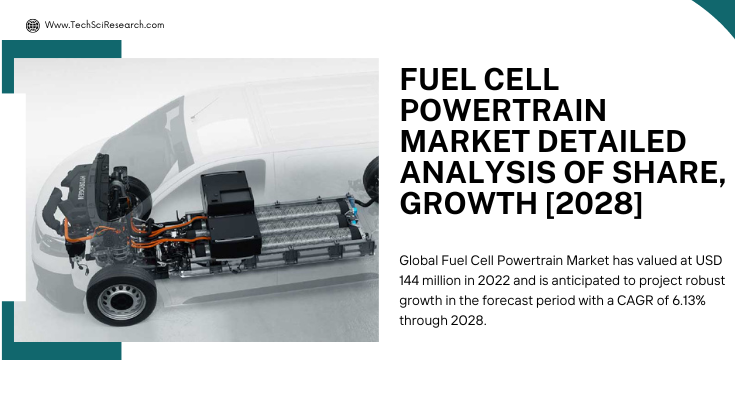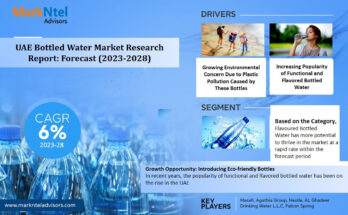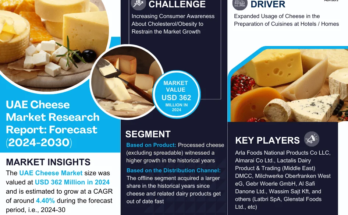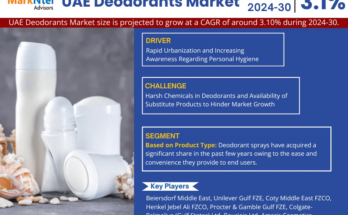According to TechSci Research report, “Global Fuel Cell Powertrain Market – Industry Size, Share, Trends, Competition Forecast & Opportunities, 2028”, the Global Fuel cell powertrain Market stood at USD 144 million in 2022 and is anticipated to grow with a CAGR of 6.13% in the forecast period, 2024-2028.
The fuel cell powertrain market has witnessed rapid development over the past few decades across the world due to the rising demand for low-emission vehicles and increasing vehicle range. During the past few years, various countries around the world have increased their focus on the growth of this industry. Rapid growth in technology and decreasing cost of fuel cells along with the rising prices of petrol and diesel have led to the rapid growth of this market.
Governments around the world have started developing infrastructure for Fuel cell powertrain vehicles and are working with OEMs to increase the market for low-emission fuel vehicles. Increased demand for efficient, long-range, and low-emission vehicles is expected to boost the market.
Browse over market data Figures spread through 180 Pages and an in-depth TOC on “Global Fuel cell powertrain Market.” @ https://www.techsciresearch.com/report/fuel-cell-powertrain-market/21069.html
The global fuel cell powertrain market is at the forefront of a transformative era in the automotive and transportation industries, embodying the shift towards sustainable and zero-emission mobility. Fuel cell powertrains, harnessing the power of electrochemical reactions between hydrogen and oxygen, represent a promising alternative to traditional internal combustion engines. As the world grapples with environmental challenges, stringent regulations, and the imperative to reduce greenhouse gas emissions, fuel cell technology emerges as a beacon of hope, offering a clean and efficient solution for powering various modes of transportation.
At the heart of the burgeoning global fuel cell powertrain market is an urgent commitment to environmental sustainability. Governments and regulatory bodies worldwide are setting stringent emission reduction targets to combat climate change and improve air quality. The transportation sector, a significant contributor to air pollution and carbon emissions, is under increasing pressure to transition towards cleaner alternatives. In response, the fuel cell powertrain has emerged as a key player in the quest for sustainable transportation.
Environmental imperatives are driving regulatory changes that incentivize the adoption of fuel cell vehicles. In regions such as Europe, where the European Green Deal aims to make the European Union climate-neutral by 2050, and various countries are implementing increasingly strict emission standards, fuel cell powertrains are gaining prominence. Governments are implementing policies that encourage automakers to invest in fuel cell technology to meet emission reduction targets, fostering an environment conducive to the growth of the fuel cell powertrain market.
The availability and sustainability of hydrogen, the fuel source for fuel cell powertrains, are critical factors influencing the market’s trajectory. Hydrogen production has undergone a transformative shift, with a growing emphasis on green hydrogen produced through renewable energy sources. Traditional hydrogen production methods, such as steam methane reforming (SMR), are carbon-intensive. However, advancements in electrolysis, a process where renewable energy is used to split water into hydrogen and oxygen, have paved the way for green hydrogen.
This transition to green hydrogen aligns with broader sustainability goals and positions fuel cell powertrains as a genuinely eco-friendly alternative. The advancements in hydrogen production technologies not only contribute to environmental conservation but also enhance the overall sustainability of the fuel cell powertrain market. As green hydrogen becomes more economically viable, the fuel cell powertrain’s competitiveness grows, fostering a symbiotic relationship between the hydrogen sector and the fuel cell market.
The versatility of fuel cell powertrains is a defining characteristic, setting them apart as a solution that transcends traditional passenger vehicles. While fuel cell technology gains traction in the automotive sector, its influence extends across diverse modes of transportation, including buses, trucks, trains, ships, and even aircraft. This wide-ranging applicability positions fuel cell powertrains as a flexible and scalable solution, contributing to zero-emission goals across various transport sectors.
In the realm of public transportation, fuel cell buses are increasingly adopted, offering zero-emission operation, longer ranges, and shorter refueling times compared to battery electric buses. Major cities and transit agencies worldwide are incorporating fuel cell buses into their fleets, contributing to cleaner air and sustainable urban mobility.
The commercial trucking sector sees the emergence of hydrogen fuel cell trucks as a solution for long-haul transportation. With extended ranges and quicker refueling times compared to battery electric trucks, fuel cell trucks address the challenges associated with heavy-duty and long-distance logistics. Major truck manufacturers and logistics companies are investing in fuel cell trucks to decarbonize freight transportation.
Fuel cell technology is making inroads into the railway industry, where fuel cell trains offer a clean alternative to diesel locomotives. Capable of operating on non-electrified rail lines, fuel cell trains provide a zero-emission solution for rail transportation. Pilot projects and initiatives worldwide are testing and implementing fuel cell trains, contributing to sustainable rail travel.
In the maritime sector, fuel cell powertrains are considered for ships and vessels to reduce emissions in ports and coastal areas. Whether providing auxiliary power or serving as the main propulsion system, fuel cell systems contribute to cleaner maritime transportation. Even the aviation industry is exploring fuel cell powertrains for smaller aircraft and drones. Hydrogen fuel cells have the potential to offer longer flight ranges and lower environmental impact compared to traditional aviation fuels, contributing to the evolution of sustainable air travel.
The diverse applications of fuel cell powertrains underscore their adaptability to different transportation needs, making them a pivotal force in the global effort to transition towards sustainable and zero-emission mobility.
Government support has emerged as a linchpin in driving the adoption of fuel cell powertrains, fostering an environment where innovation meets economic feasibility. Governments worldwide recognize the transformative potential of fuel cell technology and are implementing policies and incentives to incentivize both consumers and manufacturers to embrace fuel cell vehicles. Consumer incentives play a crucial role in stimulating demand for fuel cell vehicles.
Many governments offer financial incentives, such as tax credits, rebates, or reduced registration fees, to consumers purchasing fuel cell vehicles. By making fuel cell vehicles more affordable, these incentives encourage consumers to choose zero-emission options, fostering market penetration. In addition to consumer incentives, governments are actively supporting the development of hydrogen infrastructure. The establishment of hydrogen refueling stations is critical for the widespread adoption of fuel cell vehicles. Subsidies and funding programs are often provided to incentivize private investors and energy companies to build and expand the hydrogen infrastructure, addressing the crucial challenge of hydrogen availability.
Major companies operating in the Global Fuel cell powertrain Market are:
- Cummins Inc.
- Robert Bosch GmbH
- Denso Corporation
- Ballard Power Systems
- FEV Group
- Nuvera Fuel Cell LLC.
- Plug Power
- SFC Energy
- Bloom Energy
- Ceres Power
Download Free Sample Report @ https://www.techsciresearch.com/sample-report.aspx?cid=21069
Customers can also request for 10% free customization on this report
“The global fuel cell powertrain market is surging ahead as a pivotal player in the transformative shift towards sustainable transportation. Driven by stringent environmental regulations, advancements in green hydrogen production, diverse applications in various modes of transportation, and robust government support, fuel cell powertrains are emerging as versatile and eco-friendly solution. The market’s trajectory is characterized by a dynamic interplay of technological innovation, regulatory incentives, and collaborative efforts, positioning fuel cell technology as a key driver in the global push for zero-emission mobility. As the automotive landscape evolves, the fuel cell powertrain market stands poised for continued growth, playing a crucial role in shaping the future of clean and efficient transportation.” said Mr. Karan Chechi, Research Director with TechSci Research, a research-based management consulting firm.
“Fuel Cell Powertrain Market– Global Industry Size, Share, Trends, Opportunity, and Forecast, Segmented By Vehicle Type (Passenger Cars, LCV, HCV), By Type (Single Core, Multi-Core), By Sales Channel (OEM, Aftermarket), By Region, Competition, 2018-2028”, has evaluated the future growth potential of Global Fuel cell powertrain Market and provides statistics & information on market size, structure and future market growth. The report intends to provide cutting-edge market intelligence and help decision makers take sound investment decisions. Besides, the report also identifies and analyzes the emerging trends along with essential drivers, challenges, and opportunities in the Global Fuel cell powertrain Market.
You may also read:
United States Automotive Connectors Market – Current Analysis and Forecast [2028]
Exhaust Heat Recovery System Market – Competitive Landscape and Innovation
Selective Catalytic Reduction Market [2028]- Exploring Robust Growth & Forecast
Vehicle Tracking System Market – Rising Demand and Growth Trends
Automotive Hinges Market Set for XX.XX% CAGR Through 2028- Forecasted Growth
Table of Content-Fuel Cell Powertrain Market
- Introduction
1.1. Product Overview
1.2. Key Highlights of the Report
1.3. Market Coverage
1.4. Market Segments Covered
1.5. Research Tenure Considered
- Research Methodology
2.1. Objective of the Study
2.2. Baseline Methodology
2.3. Key Industry Partners
2.4. Major Association and Secondary Sources
2.5. Forecasting Methodology
2.6. Data Triangulation & Validation
2.7. Assumptions and Limitations
- Executive Summary
3.1. Market Overview
3.2. Market Forecast
3.3. Key Regions
3.4. Key Segments
- Impact of COVID-19 on Global Fuel cell powertrain Market
- Global Fuel cell powertrain Market Outlook
5.1. Market Size & Forecast
5.1.1. By Value
5.2. Market Share & Forecast
5.2.1. By Vehicle Type Market Share Analysis (Passenger cars, LCV, HCV)
5.2.2. By Component Type Market Share Analysis (Fuel Cell System, Battery System, Drive System, Hydrogen Storage System, Others)
5.2.3. By Drive Type Market Share Analysis (Rear Wheel Drive (RWD), Front Wheel Drive (FWD), All-Wheel Drive (AWD))
5.2.4. By Regional Market Share Analysis
5.2.4.1. Asia-Pacific Market Share Analysis
5.2.4.2. Europe & CIS Market Share Analysis
5.2.4.3. North America Market Share Analysis
5.2.4.4. South America Market Share Analysis
5.2.4.5. Middle East & Africa Market Share Analysis
5.2.5. By Company Market Share Analysis (Top 5 Companies, Others – By Value, 2022)
5.3. Global Fuel cell powertrain Market Mapping & Opportunity Assessment
5.3.1. By Vehicle Type Market Mapping & Opportunity Assessment
5.3.2. By Component Type Market Mapping & Opportunity Assessment
5.3.3. By Drive Type Market Mapping & Opportunity Assessment
5.3.4. By Regional Market Mapping & Opportunity Assessment




